The ideal temperature range for successful soap saponification is 95-140°F, with 120-130°F being perfect for most oil and lye combinations. You'll want to keep your lye solution and oils within 10°F of each other to prevent false trace or solidification. Too cold (below 95°F) causes incomplete reactions, while too hot (above 140°F) risks overheating issues like alien brain formation or soap volcanoes. Master this temperature sweet spot and watch your soap quality dramatically improve.
Perfect Temperature Range: 95-140°F for Saponification
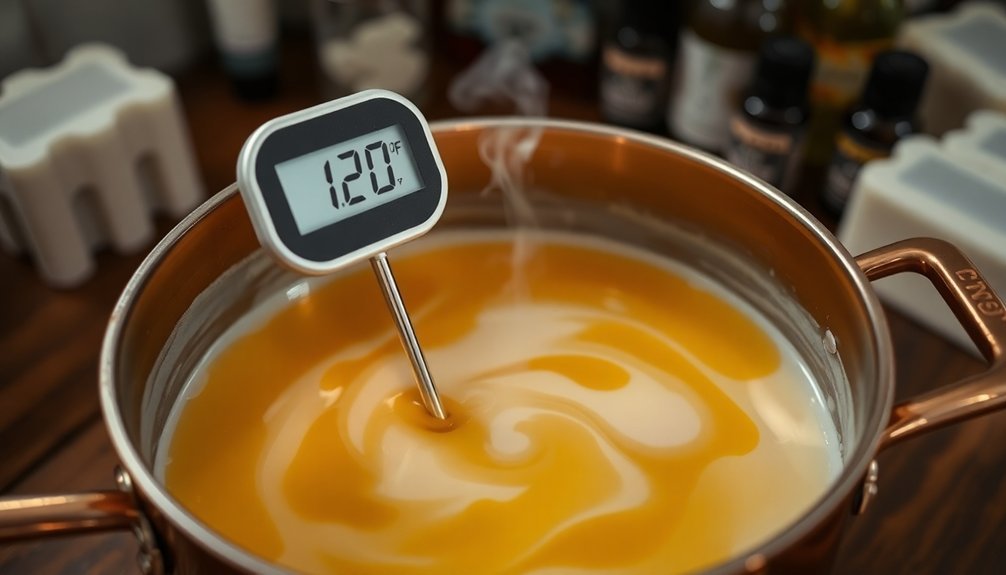
When making cold process soap, maintaining the right temperature is critical for successful saponification. The ideal temperature range falls between 95-140°F, with most soapers preferring to work at 120-130°F for both oils and lye solutions.
You'll want to keep your lye and oils within 10 degrees of each other to prevent false trace, where your soap batter appears thick but hasn't truly saponified. If temperatures drop below 95°F, oils may solidify upon contact with lye, creating unwanted clumps.
Conversely, overheating above 140°F can trigger problems like alien brain formation or glycerin rivers in your final product.
While higher temperatures accelerate saponification, careful monitoring is vital. Understanding these temperature dynamics guarantees consistent results and enhances the quality of your handcrafted soap.
The Science of Saponification and Temperature Control
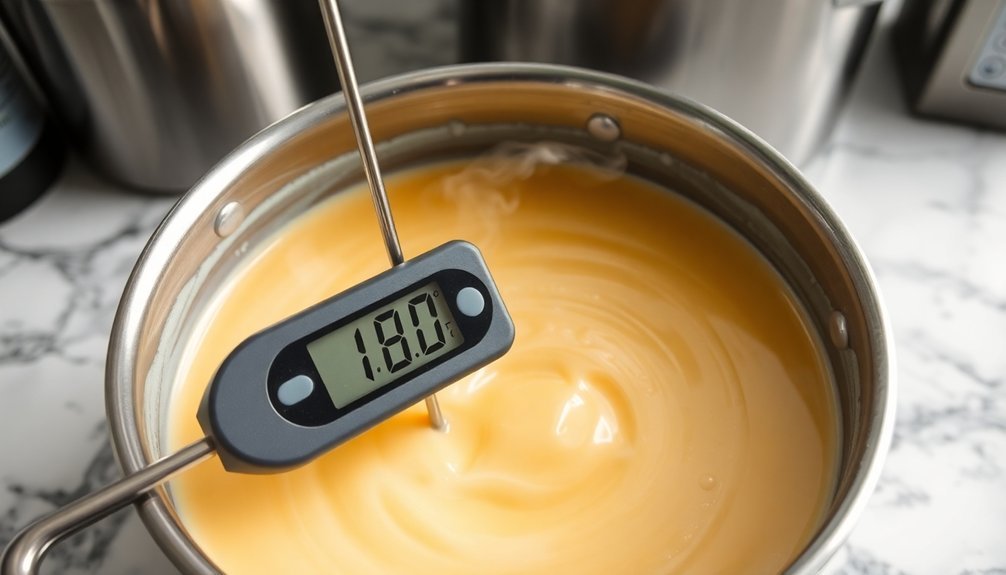
Although seemingly complex, the chemical process of saponification follows predictable physical laws that directly respond to temperature variations. When you maintain temperature control between 95-140°F, you're ensuring the chemical reaction proceeds correctly at the molecular level.
Your lye solution naturally heats to approximately 200°F during mixing—an exothermic reaction that requires cooling before combining with oils.
Temperatures outside the suitable range can trigger problematic reactions: too cold causes false trace where oils and lye appear mixed but later separate; too hot leads to overheating and soap defects like glycerin rivers or alien brain formations.
The heat transfer method leverages this science effectively—using the natural heat from your lye solution to melt solid oils while simultaneously cooling the lye to the ideal saponification temperature range.
Understanding the Critical 95-140°F Sweet Spot
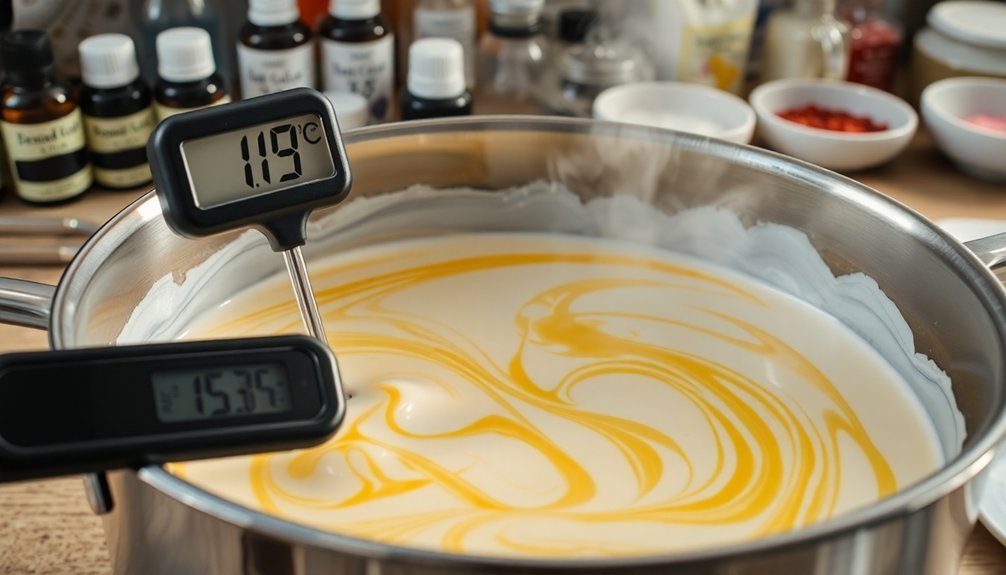
The success of your soap depends largely on maintaining temperatures within the critical 95-140°F range throughout the saponification process. This sweet spot guarantees ideal mixing between oils and lye in cold process soap making, with 120-130°F being perfect for most formulations.
- Working below 95°F increases risk of false trace as fats solidify, creating grainy soap consistency.
- Keeping lye temperatures within 10°F of your oils promotes smooth, homogenous saponification.
- The 120-130°F range provides the perfect balance between workability and reaction speed.
- Temperatures above 140°F accelerate gel phase, which can enhance colors but may cause defects.
- Proper temperature control minimizes common issues like soda ash, separation, and "alien brain" formations.
Common Temperature-Related Soap Making Failures
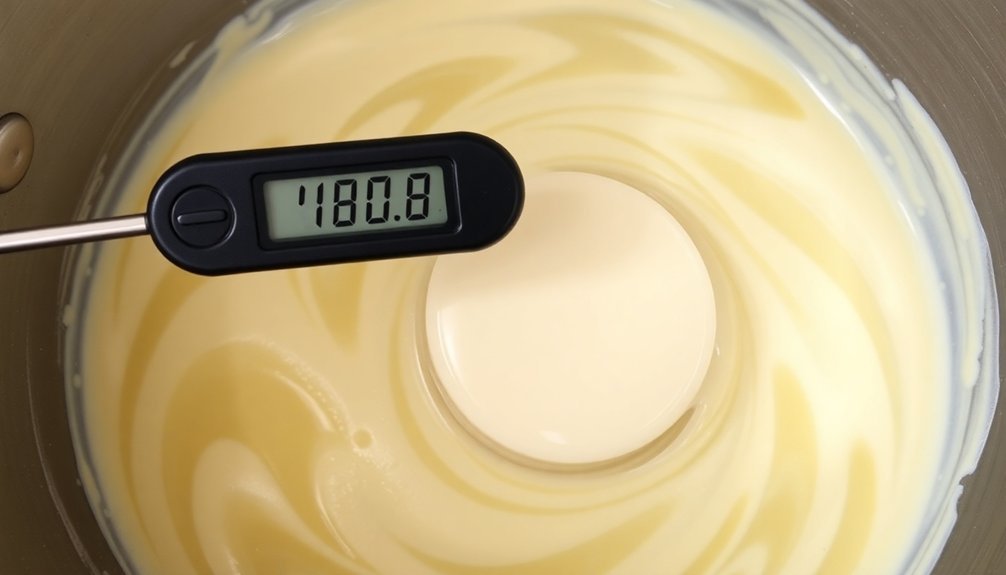
Deviating from the ideal temperature range leads to frustrating soap making failures that can transform promising batches into disappointing results.
When you overheat soap above 140°F, it enters gel phase too quickly, causing "alien brain" formations and soap volcanoes that ruin your creation's appearance.
Conversely, soap that's too cold (below 95°F) often develops soda ash—a white, powdery surface formed when unsaponified lye reacts with carbon dioxide.
You'll also encounter false trace when your lye solution is notably cooler than your oils, creating a deceptively thick, grainy batter.
Glycerin rivers—those unwanted streaks throughout your soap—result from temperature fluctuations during saponification.
Both extremes impact your final product's quality, causing separation of oils and discoloration that no amount of coloring or fragrance can mask.
Adjusting for Different Oil Compositions

Successful soap makers understand that different oil compositions demand specific temperature adjustments for ideal saponification. When crafting cold process soap, you'll need to reflect on each oil's unique melting point and behavior during saponification.
- Liquid oils like olive or sunflower work well even at room temperature, giving you flexibility in your process.
- Hard oils and butters require thorough melting at higher temperatures (120-130°F) to prevent false trace issues.
- Oil composition directly affects gel phase shift—high water soaps may need external heat for complete gel.
- Monitor temperatures of both oils and lye water carefully to maintain the ideal 120-130°F range for most recipes.
- Temperature differential between lye solution and oils should be minimal to prevent separation or saponification problems.
Effects of Environmental Conditions on Soap Temperature
While you might focus primarily on your ingredients' temperatures during soap making, environmental conditions in your workspace can dramatically affect the entire saponification process. Your ambient temperature influences how quickly oils and lye heat up, potentially causing overheating if not monitored.
| Environmental Factor | Impact on Soap-Making Process |
|---|---|
| High ambient temperature | Accelerates trace and saponification |
| Low ambient temperature | May cause false trace or incomplete saponification |
| High humidity | Increases moisture content, promoting soda ash formation |
| Dry conditions | May speed up evaporation during curing process |
| Temperature fluctuations | Can disrupt the ideal range (95-140°F) |
Consider insulating the soap during the curing process to maintain proper heat levels, especially in cooler environments. Always use a thermometer to monitor both soap temperatures and your workspace to guarantee successful saponification without complications.
Mastering the Gel Phase Through Temperature Management
The gel phase represents a pivotal stage in saponification where your soap undergoes significant chemical changes. To achieve vibrant colors and smooth texture, you'll need to maintain temperatures between 130-160°F. Proper insulation helps preserve heat, accelerating saponification while preventing soda ash formation.
- Monitor temperatures closely to avoid overheating issues like cracking or "alien brains"
- Adjust your recipe's water content strategically—high water content promotes gelling, while low water content may inhibit it
- Use insulation techniques like towel wrapping for soaps you want to gel completely
- Consider external heat sources such as ovens or heating pads for high water content formulations
- Remember that successful temperature management directly impacts your soap's final appearance and quality
Equipment and Tools for Precise Temperature Monitoring
Achieving consistent, high-quality soap requires precise temperature control throughout the saponification process. A digital thermometer is your most valuable tool, providing accurate readings to guarantee your soap making oils and lye solution remain within the ideal soaping temperature range of 120-130°F.
For quick surface temperature checks without contact, an infrared thermometer prevents potential contamination of your soap batter.
Pair these with a reliable kitchen scale that measures in grams for accurate ingredient measuring—critical for maintaining proper temperatures during saponification.
Always use heat-resistant containers, preferably glass or stainless steel, when working with lye solutions and hot oils.
Finally, monitor ambient temperatures in your soaping area, as environmental conditions greatly impact how your soap behaves during curing and can affect the final product's quality.
Temperature Techniques for Specialty Additives and Colorants
Specialty additives like honey and milk require cooler temperatures (100-110°F) to prevent overheating and maintain their beneficial properties in your soap.
When working with heat-sensitive botanicals, you'll need to monitor your batter closely and potentially reduce your starting temperatures to avoid discoloration or accelerated trace.
Colorants have specific temperature thresholds—LabColors perform best at warmer temperatures (131-160°F) for vibrant results, while natural clays and micas typically need moderate temperatures (120-130°F) for proper dispersion without clumping.
Heat-Sensitive Botanicals Management
When incorporating delicate botanicals into your soap formulations, maintaining appropriate temperature control becomes essential for preserving their therapeutic properties and vibrant colors.
To achieve ideal results, keep your soaping temperature below 140°F, with the ideal range being 95-110°F for heat-sensitive botanicals.
- Pre-steep botanicals in oils before adding the lye solution to enhance their effectiveness
- Monitor your soap closely when using heat-generating additives like honey to prevent overheating
- Implement the heat transfer method by cooling your lye solution thoroughly before combining it with oils
- Keep temperature management consistent throughout saponification to protect herbal infusions
- Consider splitting your recipe and adding delicate botanical colorants to a small, cooled portion before blending back into the main batch
Colorant Temperature Thresholds
Moving from botanical considerations to the domain of color, your soap's temperature plays a defining role in how colorants behave and appear in the final product. Most colorants perform ideally between 130-160°F, yielding vibrant colors through proper integration during saponification.
| Colorant Type | Ideal Temperature Range |
|---|---|
| LabColors | 130-160°F |
| Micas/Pigments | 120-130°F (dispersed in oils) |
| Natural Dyes | 95-120°F |
| Specialty Additives | 110-140°F |
| Color-Shifting Additives | 140-160°F (gel phase) |
For cold process soap, maintain temperatures between 95-140°F to prevent discoloration and separation. When working with micas and pigments, make sure they're well-dispersed in heated oils before adding to your soap batter. Remember that specialty additives like honey or milk require careful temperature monitoring as they can generate additional heat, affecting your colorants' final appearance.
Frequently Asked Questions
What Is the Best Temperature for Saponification?
For successful saponification, you'll find the best temperature is between 120-130°F for both oils and lye. You should keep them within 10 degrees of each other to prevent false trace issues.
What Is the Best Temperature for Curing Soap?
For curing soap, you'll want to maintain temperatures between 70-100°F. This range guarantees proper hardening without compromising quality. Keep your soaps at room temperature in a stable environment to prevent issues like soda ash formation.
What Is the Temperature of the Saponification Reaction?
The saponification reaction occurs between 95-140°F, with ideal results around 120-130°F. You'll want to keep your lye solution and oils within 10 degrees of each other for the best soap-making results.
Does Temperature Affect Saponification Value?
Temperature doesn't affect saponification value itself, which is a fixed chemical property of oils. However, it does influence the reaction rate and success of your soap-making process, impacting the final product's quality.
In Summary
You've now mastered the essential 95-140°F temperature range for successful saponification. By maintaining this sweet spot, you'll avoid common pitfalls while ensuring proper gel phase and ingredient incorporation. Remember to adjust for your specific oil blend and environmental conditions. With the right tools and techniques, you'll consistently produce beautiful, quality soap with predictable results every time you craft.

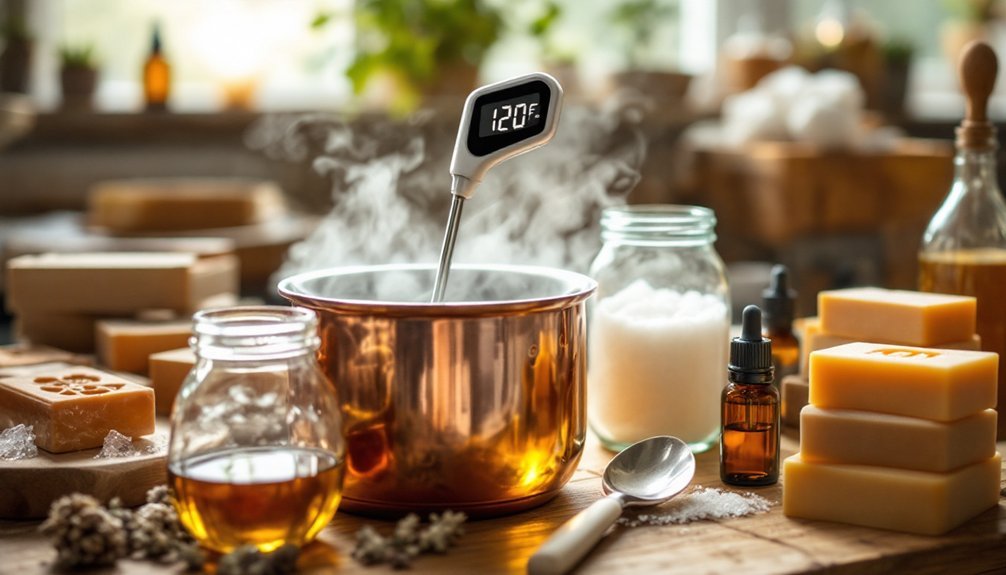



Leave a Reply